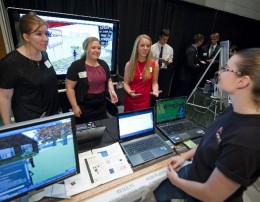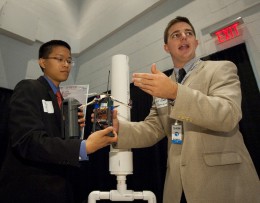
Wright State biomedical engineering students Brittany Fouts, Monica Leslie and Michelle Bricker explain their SMARTCare project to Wright State student Michelle Harr at the Summer-at-the-Edge Open House.
What did you do this summer?
Wright State engineering sophomore Jeremy Lee helped make a giant spud gun—and miniature spy drones to be fired from it.
Brittany Fouts, Monica Leslie and Michelle Bricker—all Wright State biomedical engineering students—built virtual-world homes where nursing students can visit patients, check their conditions and give blood infusions.
They were among more than 100 high school and college students who tackled more than 30 research projects this summer in the Air Force Research Laboratory’s (AFRL’s) Summer-at-the-Edge internship program.
They showed off their work Monday, August 13, in the Apollo Room of Wright State’s Student Union.
The AFRL-funded program creates teams of students ranging from high school to graduate school, some from outside Ohio. They spend 10 weeks working on technology-based projects at the Wright Brothers Institute’s Tec^Edge Innovation and Collaboration Center. AFRL also funds a similar program called Year at the Edge.
AFRL is the Air Force’s center for science and technology. Its headquarters and several research directorates are located at Wright-Patterson Air Force Base close to Wright State.
AFRL’s goal is to help develop the next generation of scientists and engineers, said Rob Williams, Ph.D., director of the Summer-at-the-Edge program. “Our focus is very simple. It’s inventing the future, one student at a time,” he said.

Wright State student Jeremy Lee and Ohio State student Jeff Blanford explain their team's micro air vehicle at the Summer-at-the-Edge Open House.
Lee, a mechanical engineering major from Hudson, worked with high school students from Centerville and Oakwood and college students from six other universities on the Tube Launched Quadrotor and Fixed Wing Micro Air Vehicle project.
The students designed and built two kinds of miniature drones—one with wings and one with four miniature rotors—designed to be folded up and fired from a launching tube. They even built a big compressed-air cannon to test-fire them—the kind of plastic-pipe contraption you might expect to see college kids using to fire potatoes.
Lee said the project was an eye-opener. No single team member had all the needed skills in engineering, mathematics and physics. They had to learn how to work together. “My mindset when I came to college was, an engineer can do everything. Which isn’t true at all,” he said.
Fouts, Leslie and Bricker also said Summer-at-the-Edge was a good way to learn how to work in teams on challenging projects—something students can’t get in a classroom. “I now know how to interact with people on projects,” said Fouts, a junior who was team leader of their SMARTCare virtual-reality project, which included four college and one high school student.
For Bricker, a 2012 Beavercreek High School graduate who’s just starting at Wright State, it was a headlong dive into her intended major.
“I chose computer science, but I wasn’t rock-solid about it. Because of my experience here, I really want to do it,” she said.
Wright State offers Wright^Edge Academic Pipeline Scholarships for Summer-at-the-Edge and Year-at-the-Edge. Students in science, technology, engineering, mathematics and medicine degree programs may be eligible to apply. Visit www.wright.edu/edge to learn more.

 Wright State’s annual Raidersgiving draws hundreds
Wright State’s annual Raidersgiving draws hundreds  Wright State named a Best for Vets College
Wright State named a Best for Vets College  Wright State’s Boonshoft School of Medicine receives full continuing accreditation from Liaison Committee on Medical Education
Wright State’s Boonshoft School of Medicine receives full continuing accreditation from Liaison Committee on Medical Education  Wright State supports deaf and hard of hearing community with Deaf Festival
Wright State supports deaf and hard of hearing community with Deaf Festival  Wright State students showcase scientific discoveries at annual research festival
Wright State students showcase scientific discoveries at annual research festival 